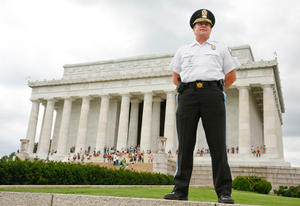Protecting monumentsU.S. struggles to solve monument protection problem
Government officials have struggled to strike the right balance between security and freedom at historical sites in the United States, with some monuments or national parks featuring stringent airport like security measures while others have a minimal security presence; the General Accounting Office (GAO) has issued two reports, one in 2003 and one in 2009, that found security at U.S. monuments were in need of improvement; The National Park Service (NPS) has more than doubled the size of its security staff, increasing its numbers from 1,500 to nearly 4,000 following the 9/11 attacks; so far, there have been no credible threats to monuments in the United States, but since the five most secure U.S. monuments have a single access entry, they are potential targets for a mass casualty attack

Balancing security with public access - not an easy task // Source: nps.gov
Government officials have struggled to strike the right balance between security and freedom at historical sites in the United States, with some monuments or national parks featuring stringent airport like security measures while others have a minimal security presence.
For instance in San Francisco, California, the Golden Gate Bridge is protected by only thirty-one bridge security officers and visitors are free to walk around the bridge and the nearby park as they please with minimal supervision. In contrast the Statue of Liberty was shut down for three years following the 9/11 attacks and only opened its crown for visitors in 2009. Visitors are required to wait in long lines behind police barricades before they enter a screening area with six metal detectors.
The use of cell phones and cameras is strictly prohibited in the screening area and visitors are not allowed to bring large backpacks, coolers, or packages. For further security, a large contingent of private security screeners and police officers is on hand.
The General Accounting Office (GAO) has issued two reports, one in 2003 and one in 2009, that found security at U.S. monuments were in need of improvement. In the 2009 report, GAO stated that the National Park Service (NPS) was poorly organized in how it managed its money, shared information, and trained its officers.
“For example, staff that are assigned security duties are generally not required to meet qualifications or undergo specialized training,” the GAO report found. “Absent a security training curriculum, there is less assurance that staff are well-equipped to effectively identify and mitigate risks at national icons and parks.”
In an email statement, Laura Kopelson, a spokeswoman for GAO, wrote, “According to the director of the national icon security review, NPS has not yet informed us of their actions on our recommendations in the 2009 report.”
David Barna, an NPS spokesman, claims that all of the 2009 report’s recommendations have been implemented. The agency has more than doubled the size of its security staff, increasing its numbers from 1,500 to nearly 4,000 following the 9/11 attacks.
So far, there have been no credible threats to monuments in the United States, but Barna says the five most secure U.S. monuments “tend to have a single access entry” making them potential targets for a mass casualty attack.
Given the potential for terrorists to target national monuments, park officials have struggled to find the proper balance between security and maintaining a tranquil and open feeling for visitors.
Mount Rushmore park rangers have received special training and equipment to prepare them to respond to a chemical attack, while security guards at Hoover Dam in Nevada inspect all vehicles, trucks, and buses that enter the parking lot.
Meanwhile at the Lincoln Memorial, a fence surrounding the top of the monument was installed after 9/11, but has since been removed following the installation of bollards that prevent cars from driving on to the National Mall.
